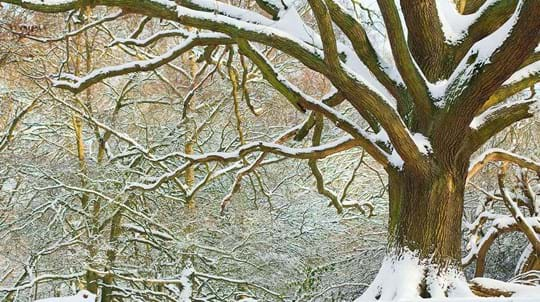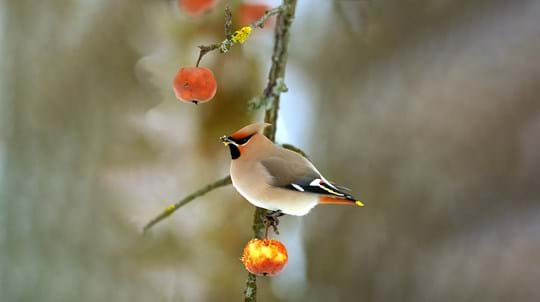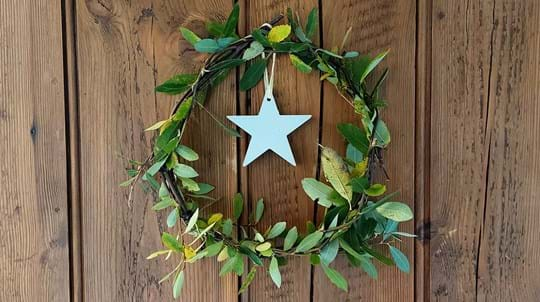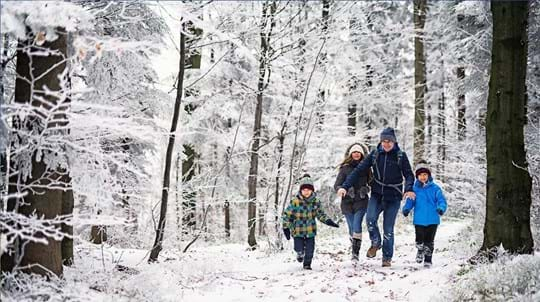
Go exploring
Primordial landscapes, tangled branches, breathtaking wildlife and miles of woodland trails. From the countryside to cities, we care for thousands of woods throughout the UK, all free to visit.
Find a wood near you
Assistant conservation evidence officer
Winter can be tough for people and wildlife, but it’s not all bleak – the season has a beauty all of its own. It's important for our mental health to stay connected with the natural world, even during the darkest, coldest months. While some species have flown south or tucked themselves away for the winter, you needn’t do the same. Here’s our guide to wildlife you can see at this time of year, plus where and when to find it.
Step out into that crisp winter air and take a wander through a woodland. Notice the details which are unveiled now that the trees stand bare. Look for intricate cow parsley stems sparkling with frost and laced with frozen spider webs. Peer between the tree trunks to spot a deer, nibbling frosty brambles, who lifts her head to stare back. Discover a range of fascinating bracket fungi clinging to naked trunks and branches. Take time to absorb and appreciate a magical winter wonderland with these special sights and more.
In winter, small birds rove the woodland in large mixed-species foraging parties. Their quiet ‘tit-tit’ contact calls give away their presence. Look up to see blue tits, coal tits, great tits, long-tailed tits, or chaffinches and bramblings flitting between the bare branches. While most other birds have given up their song for the winter, robins redouble their efforts. This makes winter a perfect time to really get to know the robin’s whistly tune. By spring, you’ll be able to pick him out in the dawn chorus.
The elder is always eager for spring – its buds burst in January.
Hazel catkins, like little cigars, are exposed by the leaf fall. Watch them from January as they transform into yellow lamb’s-tails. The tiny female hazel flowers are a speck of hot pink against the grey palette of winter, but you’ll have to look closely to find them.
You might witness a magical courtship dance, performed on the wing, by clouds of individuals who gather in woodland glades. Each male ascends slightly, then floats back down to the group before repeating his display. Their clear wings catch the low winter sunshine as they dance. It’s easy to imagine you have stumbled upon a party of tiny fairies; in fact this is the lekking behaviour of the winter gnat as they gather together and put on a competitive display to try to attract a female. One of the few insects active in winter, these gnats don’t bite so don’t be afraid to take a closer look. I can’t say the same about fairies.
At dusk, starlings, in their spotty winter plumage, gather in mind-boggling murmurations before dropping into their night-time roosts. In the bare treetops, rookeries are revealed and jackdaws, rooks and crows make a noisy spectacle on their way home to roost every evening.
Partially frozen lakes, rivers and streams force kingfishers to stay and hunt in the same spots for longer, giving us the chance to catch more than a glimpse of electric blue. Redwing and fieldfare feast on hedgerow berries. Early winter twilight means you are more likely to encounter a barn owl hunting along country roads on your way home.
Binoculars can help you get a closer look but aren’t essential for connecting with nature – don’t worry if you don’t have any.
You will enjoy your time in nature a lot more, and be able to stay out longer, if you are comfortable – so wrap up warm and waterproof with fluffy socks and sturdy water-tight boots. Hats, gloves and scarves and a flask of hot chocolate are a must for standing around waiting for the starling murmuration to start. Or take a full winter picnic!
Swatch books are a good way to ID species you spot on your walks and are less tricky than a traditional ID book to flick through while wearing gloves. Or look at our online ID guides before you go to help you learn a bullfinch from a brambling, a tawny owl call from that of a barn owl and much more.
Time your trip right - get out soon after sunrise if you can. The frosty mornings are beautiful but can soon melt away and birds are most active early in the morning, feeding to replenish the energy they lost keeping warm overnight. Or go in late afternoon to witness amazing sunsets and birds heading to roost.
Explore different habitats. The more you can visit, the larger the variety of species you’ll spot. See what you can spy in your own garden, the local city park, woodlands, fields, hedgerows, lakes, riverbanks and reedbeds.

Primordial landscapes, tangled branches, breathtaking wildlife and miles of woodland trails. From the countryside to cities, we care for thousands of woods throughout the UK, all free to visit.
Find a wood near youOur reptiles spend winter hibernating. You’re unlikely to see them until they come out to bask in spring – unless you happen to disturb one while turning your compost heap. Hedgehogs, dormice and bats are also tucked away in hibernation. In winter, insects less hardy than the winter gnat appear absent. Of course, they are still all around us, just hidden away in various life-stages.
Part of enjoying winter is the anticipation of spring’s arrival. Be mindful of what you can’t see and hear at this time of year to make the first signs of spring all the more exciting. Hear the first song thrush singing as early as January, spot snowdrop shoots peeking up from under the leaf litter and see frogs and newts return to ponds from February.
These signs of spring, and many others, are key events in the Nature’s Calendar project which tracks the effects of weather and climate change on wildlife across the UK. Join Nature’s Calendar to record your sightings – by taking just a few minutes to share what you see, you'll be adding to hundreds of years' worth of important data.

Help monitor the effects of climate change on wildlife near you. Your records contribute to a growing body of evidence on global warming.
Add your wildlife recordings
Visiting woods
Winter is a magical time to explore a different side to the woods. From cold, crisp mornings to chilly starlit evenings, discover a winter wonderland near you.

Blog
Helen Keating • 17 Dec 2020

Blog
Amy Lewis • 22 Feb 2018

Blog
Danielle Wesley • 13 Dec 2021

Blog
Charlie Mellor • 29 Nov 2018

Blog
Amy Lewis • 19 Jan 2022

Blog
Charlie Mellor • 20 Nov 2023

Blog
Helen Keating • 05 Dec 2022

Blog
Danielle Wesley • 14 Dec 2020